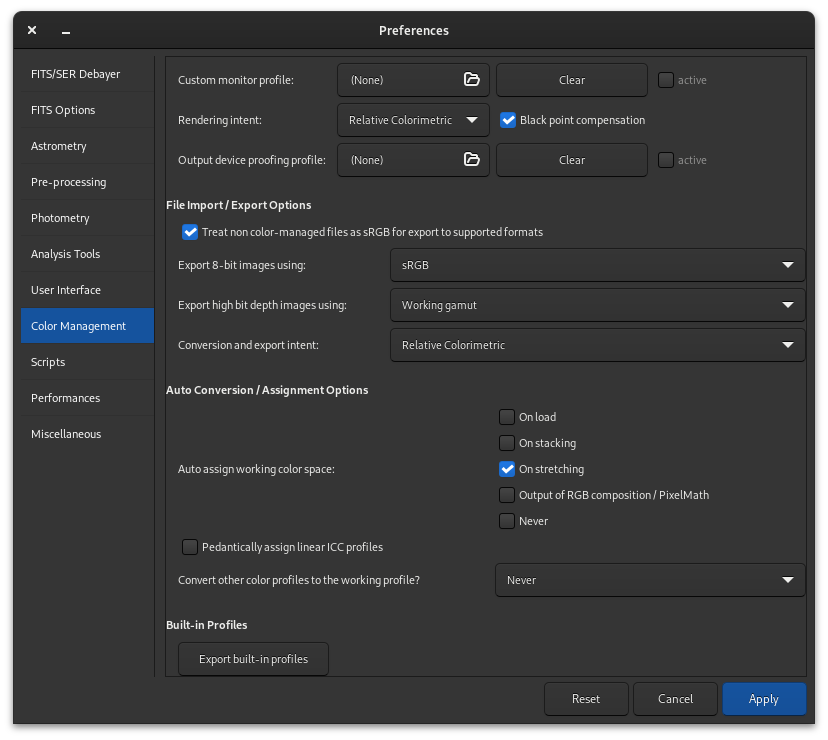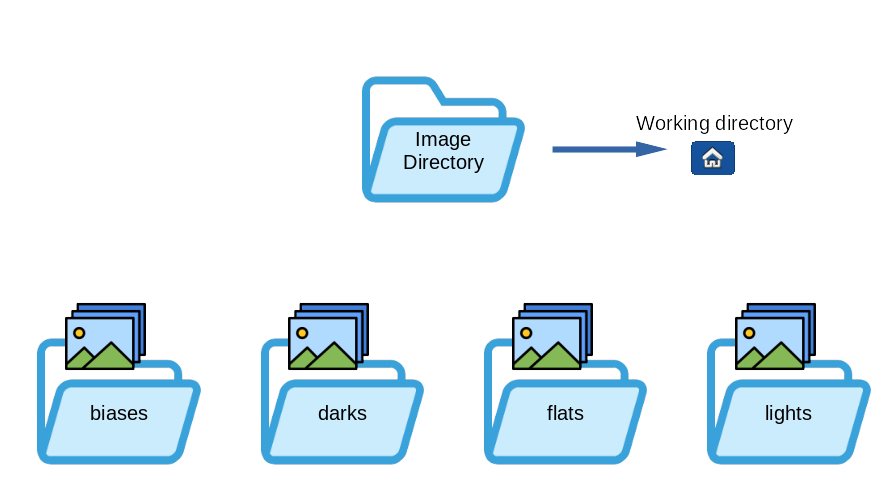Scripts
Siril has a command line in its graphical user interface and an ability to run scripts that are a list of commands, either from the graphical user interface or from the command line interface. In general, commands that modify a single image work on the currently loaded image, so the use of the load command is required in scripts, and commands that work on a sequence of images take the name of the sequence as argument. If files are not named in a way that Siril detects as a sequence, the command convert will help.
Tip
The Space character is the delimiter between arguments. If you need to have spaces inside the arguments, you can use the quote or double quote, just like in a shell.
Commands can be typed in the command line at the bottom of Siril's main window.
Another way is to put commands in a file and execute it as a script. To execute
the file from the GUI, add it to the configured script directories or from the
GUI, use the @ token of the command line like so:
@file_name
Some commands (calibrate, stack, and all save commands) can use file names containing variables coming from the FITS header. The format of the expression is explained in details here and can be tested using the parse command.
Using scripts
There are three ways to run a script:
from the graphical user interface, using the
@keyword on the command line, followed by the script name in the current working directory,from the graphical user interface, using the Scripts menu,

from the command line interface (siril-cli executable), using argument
-sfollowed by the script's path (see the man page for more info).
The scripts menu only appears if some scripts have been found in the script search directories defined either by default or by the user in the preference menu, or if scripts have been selected from the siril-scripts online repository.
Populating the list of scripts
By default, when Siril is installed, a number of scripts are automatically installed. These built-in scripts, the official ones, are developed by the development team and are guaranteed to work: they are meant to cover specific use cases.
Adding custom scripts folders
You can, of course, write your own and tell Siril where to find them:
Click on the Burger icon then on Preferences (or hit Ctrl+P).
Click on the Scripts section.
Copy to a new line the path to the location to store them (create a folder on your computer as required or point to an existing one).
Click on the Refresh icon just below.
Click on Apply.
You can have as many user-defined folders as you wish, just add them to the list.
If you have just added a new script in one of the folders and wish to refresh the menu, type the command reloadscripts in the command line or open the section and use the Refresh icon. This scans all the folders of the list and find all the files with the *.ssf extension.
Warning
It is strongly advised not to store your custom scripts within the same folder as Siril built-in scripts. On Windows, they may get wiped when installing a newer version or prevent correct uninstall. On MacOS, it will break the bundle and prevent using Siril altogether.
Don't worry, as the list of scripts locations is stored in your configuration file, you should find them back when installing a newer version.
Troubleshooting
For different reasons, it is possible that the Scripts menu is not visible. This means that the scripts have not been found. If this is the case, please use the following procedure.
Click on the Burger icon then on Preferences.
Click on the Scripts section.
Delete all the lines in the field Script Storage Directories as shown in the illustration below.
If you are using the scripts repository, deselect the Fetch and update scripts... check box, then reselect it and select the scripts you want to use.
Click on Apply.
Close and restart Siril.

Script page of preferences. The script are loaded from the paths listed in the Script Storage Directories.
Built-in scripts
All built-in scripts must follow this file structure:

Mono_Preprocessing.ssf: script for monochrome DSLR or Astro camera preprocessing, uses biases, flats and darks, registers and stacks the images. To use it: put your files (RAW or FITs) in the folders named
lights,darks,flatsandbiases(in the Siril default working folder), then run the script.OSC_Preprocessing.ssf: same script as above but for One-Shot Color (OSC) DSLR or Astro camera. To use it: put your files (RAW or FITS) in the folders named
lights,darks,flatsandbiases(in the Siril default working folder), then run the script.OSC_Preprocessing_BayerDrizzle.ssf: same script as above but using Bayer Drizzle to retrieve colors. To use it: put your files (RAW or FITS) in the folders named
lights,darks,flatsandbiases(in the Siril default working folder), then run the script. A large amount of data is strongly recommended to take advantage of the benefits of Bayer Drizzle and avoid unsightly artifacts.OSC_Extract_Ha.ssf: script for OSC DSLR or astro camera preprocessing, for use with Ha filter or dual-band filter. This script extracts the Ha layer of the color image. To use it: put your files (RAW or FITs) in the folders named
lights,darks,flatsandbiases(in the Siril default working folder), then run the script.OSC_Extract_HaOIII.ssf: same script as above, but extracts Ha and OIII layers of the color image. To use it: put your files (RAW or FITs) in the folders named
lights,darks,flatsandbiases(in the Siril default working folder), then run the script. You can also use the menu Image Processing then RGB compositing and put Ha result in Red channel and OIII result in Green and Blue layers to get an HOO image.Tip
For owners of SII or SII-OIII dualband filters, the same scripts apply. In fact, it's impossible for a color sensor to see the difference between Ha (656.3 nm) and SII (671.6 nm), both of which are red.
RGB_Composition.ssf: This script added in version 1.2 registers monochrome images with a global registration, reframes them to their common area, and takes the first three images to create a color image. The input images should be put alone in a directory and named
R.fit(or with the configured extension),G.fitandB.fit. The result will be namedrgb.fit. Make sure you remove theprocessdirectory between each run.
Language of scripts
At the beginning of the scripts, and thanks to the contribution of a user, the scripts existed in two versions (English, and French). When Siril 1.2.0 was released, it was decided to keep only the English scripts for simplicity of maintenance. We encourage users to distribute translations of the official scripts to their respective communities if they deem it necessary.
Getting more scripts
There are a whole bunch of scripts that don't come with Siril installation. However, we've set up a gitlab repository for them. Everyone is free to register and propose new scripts. We'll accept them according to their relevance: the language used must be English.
Siril features git integration which means that it can download and synchronise a local copy of the repository. You can enable this by selecting the Enable use of the siril-scripts online repository check box in the Scripts tab of the Preferences dialog.
Selecting the check box will fetch scripts from the repository and show a list of the available scripts, categorised as either "Preprocessing" or "Processing" scripts. As there may eventually be a substantial number of scripts in the repository you need to select the ones you wish to have available in the Scripts menu. Click the check box next to the name of each script you wish to use and then press the Apply button.
The contents of any script can be viewed by double-clicking on its row in the list. It is always useful to do this to check what requirements the script may have in terms of pre-prepared directories. If you wish to modify a script, you can also use this to copy the script and paste it into your favourite text editor software. (You will need to save it in one of your local script directories.)
When the scripts repository is enabled, Siril can synchronise the local repository with the remote, either manually or automatically. If automatic updates are selected, updating will take place at application startup. Manual update is also available using the Manual update button. This will fetch any changes from the online repository and will show a list of the commit messages describing the changes, which the user must confirm to apply the update.
You can also refer to the address below to browse the scripts and download them manually if you don't wish to use the git integration. In that case you will need to manually place scripts you download into a script path known to Siril: https://gitlab.com/free-astro/siril-scripts.
Warning
Keep in mind, however, that these scripts are not necessarily maintained by the users who uploaded them, and may not be up to date. That said, have fun.
Writing your own
A script file is a simple text file with the extension *.ssf.
Writing a script is not difficult. It is a succession of calls to commands
that will be executed sequentially. Each command must be executed without
returning an error, otherwise the script stops. It is therefore strongly
recommended to use the list of commands to know the
syntax and the number of parameters needed. Also, some commands are not
scriptable and are indicated with the icon. It can also be
useful to test each script line in the Siril command line. You may wish to read
the provided scripts or view (or even modify) scripts from the repository as
examples.
Each script should contain a comment header containing information about the script. An example of this is provided below.
############################################
#
# Script for Siril 1.0
# July 2020
# (C) Cyril Richard
# Mono_Preprocessing_WithoutDark v1.0
#
########### PREPROCESSING SCRIPT ###########
#
# Script for mono camera preprocessing
#
# Needs 3 sets of RAW images in the working
# directory, within 4 directories:
# biases/
# flats/
# lights/
#
############################################
Below the comment header the first command should be requires. This specifies the minimum version of Siril required to use the script. For example:
requires 0.99.4
After this you can start the actual script. Commands go on a line of their own, and you can comment your script using lines starting with #.
Each new script created in this way should be placed in a user-defined folder for Siril to find them. If you believe your script is of benefit to the wider Siril community you may submit it to the script repository. Instructions on doing so are found in the repository README.